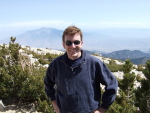Elizabeth and I spent several hours on a pleasant Sunday wandering around the LA Times Festival Of Books, held on the campus of UCLA. Los Angeles is moving towards "June Gloom" weather, with the marine layer burning off in the late morning and sliding back in the early evening, but it was clear and sunny when we were out. We walked around Royce Hall, observing the people at the Festival as much as exhibitors in their tents.
I convinced Elizabeth to go to a panel discussion of Science Fiction writers, titled "Science Fiction: The Road From Here to There". The panel consisted of John Scalzi, Harry Turtledove, Cory Doctorow, and Kage Baker. I wasn't familiar with Ms. Baker's work. I had recently read and enjoyed Scalzi's "Old Man's War", and I need to pick up the sequel. I've read several of Harry Turtledove's short stories. I'm familiar with Cory Doctorow's writing in Wired, Make Magazine and the website BoingBoing.
It is always interesting to hear authors discuss their work and milieu. I wouldn't be terribly surprised if Scalzi and Doctorow have done many of these types of discussions, as they both had too many interesting thoughts (and stated too eloquently) to not have had many chances to practice. There was some interesting discussion about the marketing aspects of the internet. Doctorow (sidenote: I'm sad to hear that he's leaving LA, as I would rather have interesting people nearby) quoted Tim O'Reilly saying "His biggest problem is NOT piracy. His biggest problem is obscurity." The panel agreed, however, that simply giving away books for free on the internet is not a silver bullet: It can be helpful to build attention (because it is easy for fans to share links to good stories), but a solid base of fans is necessary. The panel also discussed some of the offshoots of SF, including movies, television, and comic books, and pointed out that SF book conventions usually have about 1000 attendees, while comic book conventions have more like 10,000 attendees. But, they touch on similar subjects, and the other genres often look to books for inspiration.
Of the first questions (asked by Turtledove, the moderator) discussed was "why isn't the present like what was envisioned by the SF writers of the 'Golden Age'". E.g. Where's my flying car? Scalzi pointed out that the SF visions of that time were based on large monolithic organizations, very much in tune with the culture in that time. Things really didn't work out that way: The monolithic organizations (corporations and governments, I guess) had other priorities, and much of the technological changes have been around information tech (i.e. computers) rather than space travel. Doctorow pointed out that one of the truly unique ideas out there is the idea that collaboration costs are so low that people can develop large-scale projects without a monolithic organizational structure. Another unique ideas is that of the Singularity: We've had visions of things getting worse and worse until the Apocalypse (rough beasts slouching around and all that), and visions of things staying mostly the same or plodding along slowly (e.g. Asimov's galactic empire), but it is unique that some people have started to think that things will get better and better until we just pop with greatness. (We shall see.)
The panel made a very important observation, related to the discussion of the visions from the "Golden Age". Science Fiction really deals with the issues and problems in the present. Placing the setting of the stories in the future enables the authors to slyly write about current manifestations of human nature without having to be explicit. Present-day SF will deal with present-day issues, including extrapolations of present-day technology.
Elizabeth and I have enjoyed hearing authors talk at the Festival Of Books in previous years, and we hope to make it an annual event.


